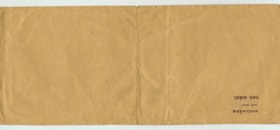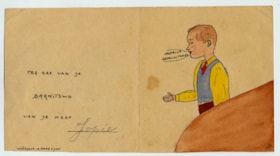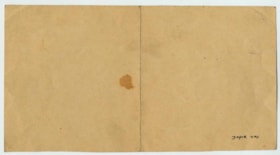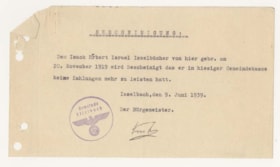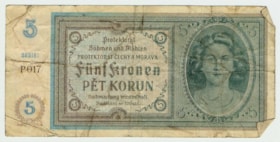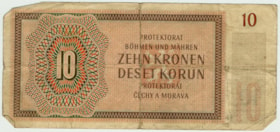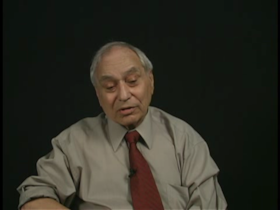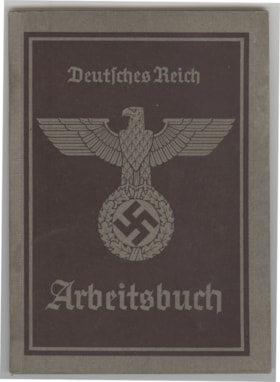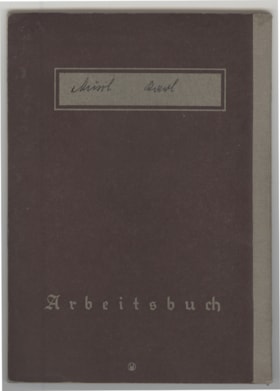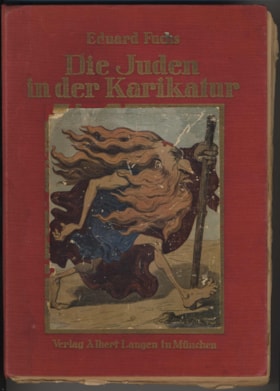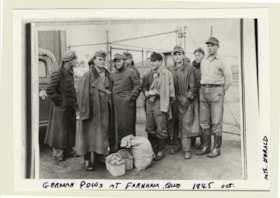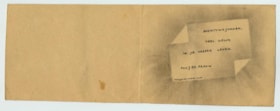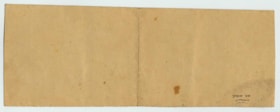Narrow Results By
Place
- Amsterdam, Netherlands, Europe 1
- Bad Wurzach, Germany, Europe 5
- Bergen-Belsen, Germany, Europe 1
- Berlin, Germany, Europe 1
- Brussels, Belgium, Europe 2
- Czech Republic (Protectorate of Bohemia and Moravia), Europe 2
- Drancy, France, Europe 1
- Europe 1
- Farnham, Canada, North America 2
- France, Europe 1
- Germany, Europe 6
- Isselbach, Germany, Europe 1
Armband
https://www.cjhn.ca/link/cjhn51219
- Collection
- Montreal Holocaust Museum
- Description Level
- Item
- Material Type
- object
- Physical Description
- Armband : printed, embroidered : White, Black ; Ht: 3,75 in. x W: 12,5 in.
- Date
- 1939-1945
- Collection
- Montreal Holocaust Museum
- Description Level
- Item
- Material Type
- object
- Physical Description
- Armband : printed, embroidered : White, Black ; Ht: 3,75 in. x W: 12,5 in.
- Other Title Information
- Personal Symbol
- Date
- 1939-1945
- Physical Condition
- Good
- Language
- German
- Notes
- Rectangular armband with three snaps. It served as identification for a forced labourer. This armband was given in Drancy internment camp to a hungarian Jew named Pal Link. Narrative: This armband belonged to Pal Link, the donor's father. In 1940, Pal was away from his home and family in Budapest for business and found himself stuck in France when the Germans invaded the country. He fled to Normandy hoping to escape to England but was unsuccessful. With false papers given to him by a local policeman, he managed to reach Nice in the South of France. Once the free zone was invaded, Pal went into hiding in the Alps but was denounced and deported to the Drancy internment camp. On the way to the camp, a soldier advised him to lie about his employment. Pal had a business exporting agricultural products but declared he was a stoker, and was put to work as such. This is how he survived from the end of 1943 to the summer of 1944 when the last inmates were let go in exchange for German soldiers. Pal survived the Holocaust and immigrated to Montreal where his son, Andre was living.
- Accession No.
- 2011X.221.01
- Name Access
- Link, André
- Places
- Drancy, France, Europe
- Archival / Genealogical
- Archival Descriptions
- Repository
- Montreal Holocaust Museum
Images
Card
https://www.cjhn.ca/link/cjhn50311
- Collection
- Montreal Holocaust Museum
- Description Level
- Item
- Material Type
- textual record
- Physical Description
- Card : Paper : Ink : Black, Yellow, Beige ; Ht: 4 in. x W: 9,3 in.
- Date
- February 24, 1945
- Collection
- Montreal Holocaust Museum
- Description Level
- Item
- Material Type
- textual record
- Physical Description
- Card : Paper : Ink : Black, Yellow, Beige ; Ht: 4 in. x W: 9,3 in.
- Other Title Information
- Documentary Artifact
- Date
- February 24, 1945
- Physical Condition
- Excellent
- Language
- Dutch
- Hebrew
- Notes
- 1 page. The right hand side shows the tablets of the law written in Hebrew with the Star of David on top. Left hand side is a message of congratulations. Narrative: Donor's grandfather was born in Britain in 1895. He moved to Holland when he was six years old . The family therefore qualified for British citizenship. Donor's father applied for British identification papers. Donor Nettie and her brother Joseph went briefly into hiding but their mother wanted the family together so they returned to Amsterdam. The family was rounded up on March 17th 1943, and taken to the Stadsschouwburg (a big cinema with seats removed) in Amsterdam where they stayed for about a week. From there they were sent to the camp of Westerbork, where they stayed for a couple of months. In the summer time they were sent to another camp in Amersfoort for about 4-6 weeks. They were afterwards sent back to Westerbork and at the beginning of 1944, the entire family was sent to Bergen-Belsen concentration camp in Germany. In Bergen-Belsen, the men and women were separated; the children from the age of 14 were sent to work. Nettie was considered small in stature, she lied about her age so she didn’t have to go to work. Her sister was three years older and was sent to work in the kitchen. Their father worked in a shoe factory and their mother worked in the kitchen peeling potatoes. Joseph (Nettie's younger brother) stayed in the camp with her. The family stayed in Bergen-Belsen until the end of 1944 (circa October or December) when they were sent to Wurzach with about. While on the train to Wurzach, the family had a separate carriage and they were told to take off the yellow stars because they were now considered internees. Additional research shows that in the winter 1944/1945 the castle of Bad Wurzach (160 km south of Stuttgart) served as a stopover for 72 Jewish prisoners from the concentration camp Bergen-Belsen. They were Jews from Holland, who were foreign nationals, meaning they had either the British or U.S. citizenship or at least papers from South and Central American countries, and were regarded as "exchangeable" over German nationals in Allied custody. They had been sent in two shipments in the fall and winter from concentration camps in Germany, in order to be exchanged in Switzerland against German citizens held by the Allies. They were sent to different internment camps of Württemberg: Liebenau, Biberach and Wurzach. According to internees from Jersey already living in Bad Wurzach, the so-called "exchange Jews" were in a terrible state when they arrived; they were starved and scared. Through improved nutrition and the additional Red Cross parcels, they recovered relatively quickly. Only one of them perished in Wurzach . While in Wurzach, Joseph celebrated his bar mitzvah on February 24th, 1945; many internees including non-Jewish internees were present. Coffee and cakes were served; thanks to a monthly parcel from POWs (milk, sugar, cocoa) which had been saved to be used for the occasion. Joseph received bar mitzvah cards made by attendees. The family stayed in Wurzach until the end of April when the camp was liberated.
- Accession No.
- 1990.13.03
- Name Access
- Herscher, Nettie
- Places
- Bad Wurzach, Germany, Europe
- Archival / Genealogical
- Archival Descriptions
- Repository
- Montreal Holocaust Museum
Images
Card
https://www.cjhn.ca/link/cjhn50312
- Collection
- Montreal Holocaust Museum
- Description Level
- Item
- Material Type
- textual record
- Physical Description
- Card : Paper : Ink; Pencil : Blue, Red, Black, Beige ; Ht: 5 in. x W: 12 in.
- Date
- February 24, 1945
- Collection
- Montreal Holocaust Museum
- Description Level
- Item
- Material Type
- textual record
- Physical Description
- Card : Paper : Ink; Pencil : Blue, Red, Black, Beige ; Ht: 5 in. x W: 12 in.
- Other Title Information
- Documentary Artifact
- Date
- February 24, 1945
- Physical Condition
- Excellent
- Language
- Dutch
- Notes
- 1 page. On the right hand side there is the Star of David above a Torah scroll with a pointer and a prayer book.Left side contains message of congratulations. Narrative: Donor's grandfather was born in Britain in 1895. He moved to Holland when he was six years old . The family therefore qualified for British citizenship. Donor's father applied for British identification papers. Donor Nettie and her brother Joseph went briefly into hiding but their mother wanted the family together so they returned to Amsterdam. The family was rounded up on March 17th 1943, and taken to the Stadsschouwburg (a big cinema with seats removed) in Amsterdam where they stayed for about a week. From there they were sent to the camp of Westerbork, where they stayed for a couple of months. In the summer time they were sent to another camp in Amersfoort for about 4-6 weeks. They were afterwards sent back to Westerbork and at the beginning of 1944, the entire family was sent to Bergen-Belsen concentration camp in Germany. In Bergen-Belsen, the men and women were separated; the children from the age of 14 were sent to work. Nettie was considered small in stature, she lied about her age so she didn’t have to go to work. Her sister was three years older and was sent to work in the kitchen. Their father worked in a shoe factory and their mother worked in the kitchen peeling potatoes. Joseph (Nettie's younger brother) stayed in the camp with her. The family stayed in Bergen-Belsen until the end of 1944 (circa October or December) when they were sent to Wurzach with about. While on the train to Wurzach, the family had a separate carriage and they were told to take off the yellow stars because they were now considered internees. Additional research shows that in the winter 1944/1945 the castle of Bad Wurzach (160 km south of Stuttgart) served as a stopover for 72 Jewish prisoners from the concentration camp Bergen-Belsen. They were Jews from Holland, who were foreign nationals, meaning they had either the British or U.S. citizenship or at least papers from South and Central American countries, and were regarded as "exchangeable" over German nationals in Allied custody. They had been sent in two shipments in the fall and winter from concentration camps in Germany, in order to be exchanged in Switzerland against German citizens held by the Allies. They were sent to different internment camps of Württemberg: Liebenau, Biberach and Wurzach. According to internees from Jersey already living in Bad Wurzach, the so-called "exchange Jews" were in a terrible state when they arrived; they were starved and scared. Through improved nutrition and the additional Red Cross parcels, they recovered relatively quickly. Only one of them perished in Wurzach . While in Wurzach, Joseph celebrated his bar mitzvah on February 24th, 1945; many internees including non-Jewish internees were present. Coffee and cakes were served; thanks to a monthly parcel from POWs (milk, sugar, cocoa) which had been saved to be used for the occasion. Joseph received bar mitzvah cards made by attendees. The family stayed in Wurzach until the end of April when the camp was liberated.
- Accession No.
- 1990.13.08
- Name Access
- Herscher, Nettie
- Places
- Bad Wurzach, Germany, Europe
- Archival / Genealogical
- Archival Descriptions
- Repository
- Montreal Holocaust Museum
Images
Card
https://www.cjhn.ca/link/cjhn50313
- Collection
- Montreal Holocaust Museum
- Description Level
- Item
- Material Type
- textual record
- Physical Description
- Card : Paper : Pencil; Ink : Yellow, Black, Blue, Red, White ; Ht: 4 in. x W: 7,5 in.
- Date
- February 24, 1945
- Collection
- Montreal Holocaust Museum
- Description Level
- Item
- Material Type
- textual record
- Physical Description
- Card : Paper : Pencil; Ink : Yellow, Black, Blue, Red, White ; Ht: 4 in. x W: 7,5 in.
- Other Title Information
- Documentary Artifact
- Date
- February 24, 1945
- Physical Condition
- Excellent
- Language
- Dutch
- Notes
- 1 page. Right hand side shows a drawing of young boy wearing shirt, sweater and tie with his hand extended and a text bubble coming from his mouth reading "congratulations" Narrative: Donor's grandfather was born in Britain in 1895. He moved to Holland when he was six years old . The family therefore qualified for British citizenship. Donor's father applied for British identification papers. Donor Nettie and her brother Joseph went briefly into hiding but their mother wanted the family together so they returned to Amsterdam. The family was rounded up on March 17th 1943, and taken to the Stadsschouwburg (a big cinema with seats removed) in Amsterdam where they stayed for about a week. From there they were sent to the camp of Westerbork, where they stayed for a couple of months. In the summer time they were sent to another camp in Amersfoort for about 4-6 weeks. They were afterwards sent back to Westerbork and at the beginning of 1944, the entire family was sent to Bergen-Belsen concentration camp in Germany. In Bergen-Belsen, the men and women were separated; the children from the age of 14 were sent to work. Nettie was considered small in stature, she lied about her age so she didn’t have to go to work. Her sister was three years older and was sent to work in the kitchen. Their father worked in a shoe factory and their mother worked in the kitchen peeling potatoes. Joseph (Nettie's younger brother) stayed in the camp with her. The family stayed in Bergen-Belsen until the end of 1944 (circa October or December) when they were sent to Wurzach with about. While on the train to Wurzach, the family had a separate carriage and they were told to take off the yellow stars because they were now considered internees. Additional research shows that in the winter 1944/1945 the castle of Bad Wurzach (160 km south of Stuttgart) served as a stopover for 72 Jewish prisoners from the concentration camp Bergen-Belsen. They were Jews from Holland, who were foreign nationals, meaning they had either the British or U.S. citizenship or at least papers from South and Central American countries, and were regarded as "exchangeable" over German nationals in Allied custody. They had been sent in two shipments in the fall and winter from concentration camps in Germany, in order to be exchanged in Switzerland against German citizens held by the Allies. They were sent to different internment camps of Württemberg: Liebenau, Biberach and Wurzach. According to internees from Jersey already living in Bad Wurzach, the so-called "exchange Jews" were in a terrible state when they arrived; they were starved and scared. Through improved nutrition and the additional Red Cross parcels, they recovered relatively quickly. Only one of them perished in Wurzach . While in Wurzach, Joseph celebrated his bar mitzvah on February 24th, 1945; many internees including non-Jewish internees were present. Coffee and cakes were served; thanks to a monthly parcel from POWs (milk, sugar, cocoa) which had been saved to be used for the occasion. Joseph received bar mitzvah cards made by attendees. The family stayed in Wurzach until the end of April when the camp was liberated.
- Accession No.
- 1990.13.07
- Name Access
- Herscher, Nettie
- Places
- Bad Wurzach, Germany, Europe
- Archival / Genealogical
- Archival Descriptions
- Repository
- Montreal Holocaust Museum
Images
Certificate
https://www.cjhn.ca/link/cjhn59461
- Collection
- Montreal Holocaust Museum
- Description Level
- Item
- Material Type
- textual record
- Physical Description
- Certificate : Paper : Typewritten : Ink : Beige, black ; Ht: 11 cm x W: 21 cm
- Date
- June 09, 1939
- Collection
- Montreal Holocaust Museum
- Description Level
- Item
- Material Type
- textual record
- Physical Description
- Certificate : Paper : Typewritten : Ink : Beige, black ; Ht: 11 cm x W: 21 cm
- Other Title Information
- Documentary Artifact
- Date
- June 09, 1939
- Physical Condition
- Good
- Language
- German
- Notes
- Page with multiple holes punched on left edge, Nazi ink stamp, entitled "Bescheinigung" (certificate). Certificate to Herbert Isselbaecher. It says that he doesn’t have to pay anything to the community of Isselbach. This document was necessary to get permission to leave the country in 1939. Narrative: Isaac Herbert Isselbacher was born 1919-11-20 in Isselbach, Germany. His brother was Helmut Isselbacher, born 1921-12-20. Their father was Jacob Isselbacher, born 1883-08-05. They had an uncle and aunt, David and Betty Loewenstein, who lived in New York City with their two children. Isaac left Germany on 1939-07-29, hoping to join his relatives in NYC. He only had the time to get to London, England before the war broke out and started working in a factory. He was arrested at his workplace as an ‘enemy alien’ and sent to Canada for internment in 1940. Isaac was interned in Camp N in Sherbrooke, Quebec. He was drafted into the Works Program Division for woodworking and net-making. In 1940, he received a last letter from his parents which suggested their imminent deportation. After his release, circa November 1942, Isaac worked as a locksmith. He married Fanny Azeff on 1943-12-26 at the Bnai Jacob synagogue in Montreal. Fanny was born on 1921-12-23 in Canada, the daughter of Mr. and Mrs. Harry Azeff. Isaac was naturalized as a Canadian citizen on 1946-06-08. Fanny was naturalized on 1946-08-30 (she had lost her citizenship by marrying Isaac). Isaac’s brother, Helmut Isselbacher, was deported with Transport XXII A from Dossin casern in Mechelen (Malines), Belgium to Auschwitz Birkenau, Poland on 1943-09-20. Of the 2,450 people on the transport, 100 men were selected to work –including Helmut- and the remainder prisoners were gassed. Helmut was made to work as a welder, and was soon fitting new pipes for the gas chamber. He suffered a nervous breakdown as a result. As he was a valued welder, he was transferred to a labour camp in Upper Silesia (Poland) where he remained for two years. As the Russian army advanced, the 6,000 prisoners of this camp were evacuated by train. Helmut remembered being forced to march as the other prisoners died from exhaustion. When liberation was announced, the survivors travelled by ship from Luebeck, Germany, to Sweden with the aid of the Red Cross. After recovery, Helmut decided to remain in Sweden as a welder. Upon learning of his brother’s survival, Helmut travelled to New York in April 1946 to meet with him and their Loewenstein relatives. Afterwards, Helmut travelled to Canada bringing with him a washing machine and bras as late wedding presents for his brother and Fanny. By 1946-08-12, their parents were presumed dead and the two sons inquired into their estate. They received a deed for the land and travelled to the estate to discover that the current owner of their house was their old maid and her son had become the town mayor. Various disputes arose with the current ‘owners’ who believed the Isselbacher family dead. Isaac wished to discuss a settlement, but the mayor’s mother –not realizing Fanny understood German- called the neighbours at work to warn them not to come home as the Isselbacher sons had resurfaced. Payment for the land had reportedly been sent to Israel, though no documentation could be provided.
- Accession No.
- 1999.1.87
- Name Access
- Issley, Jason
- Places
- Isselbach, Germany, Europe
- Archival / Genealogical
- Archival Descriptions
- Repository
- Montreal Holocaust Museum
Images
Certificate
https://www.cjhn.ca/link/cjhn75206
- Collection
- Montreal Holocaust Museum
- Description Level
- Item
- Material Type
- textual record
- Physical Description
- Certificate : Paper : Ink : Black, White, Purple
- Date
- March 13, 1952
- Collection
- Montreal Holocaust Museum
- Description Level
- Item
- Material Type
- textual record
- Physical Description
- Certificate : Paper : Ink : Black, White, Purple
- Other Title Information
- Documentary Artifact
- Date
- March 13, 1952
- Physical Condition
- Good
- Language
- German
- Notes
- 1 page, crest for Republic of Austria at top in the center, issued by Vienna city council, information about Heiss family (Salomon, Sara, Erika), emigrating to Israel. Circular ink stamp in the bottom left corner with the Republic of Austria's crest in the middle. Circular ink stamp on back from Austria general consulate in Tel Aviv Narrative: Salomon Heiss was born in Poland in 1902. At the outbreak of the First World War in 1914, his family left the country for Austria. In 1930 he married Sarah Herman, who was also from Poland. Together they opened a delicatessen store in Vienna circa 1933. Their daughter Erika (donor) was born in 1939. In 1938, Salomon was detained in Dachau concentration camp for three days. Sarah paid a guard to let him out and 24 hours later they left for Shanghai with their 3 months old daughter. They stayed there for 10 year until immigrating to Israel then Canada where they landed in Quebec city in 1953
- Accession No.
- 2002.41.4
- Name Access
- Bloom, Erika
- Places
- Vienna, Austria, Europe
- Archival / Genealogical
- Archival Descriptions
- Repository
- Montreal Holocaust Museum
Images
Commemorative badge
https://www.cjhn.ca/link/cjhn75218
- Collection
- Montreal Holocaust Museum
- Description Level
- Item
- Material Type
- object
- Physical Description
- Commemorative badge : enameled, soldered ; Ht: 5,5 cm x W: 1,3 cm
- Date
- 1933-1945
- Collection
- Montreal Holocaust Museum
- Description Level
- Item
- Material Type
- object
- Physical Description
- Commemorative badge : enameled, soldered ; Ht: 5,5 cm x W: 1,3 cm
- Other Title Information
- Documentary Artifact
- Date
- 1933-1945
- Physical Condition
- Good
- Notes
- The medal is a downward facing triangle. Top half is a black lighthouse on a white background. Bottom half is a downward facing red triangle in the middle of which is a circle, inside of which is a black swastika on a white background. The contours of the medal, the lighthouse, the swastika and the circle are medal-coloured, as well as the details of the lighthouse. The medal is soldered to a medal pin. Narrative: This stickpin was given to veterans from the First World War, to military, civilian and political individuals for their service to the Nation. In the case of military personel, a full size medal was awarded along with the stickpin. Originally the Kyffhäuserbund was a section of the Deutscher Kriegerbund (German Warrior League). Deutscher Kriegerbund (German Warrior League) was a War Veterans' and reservists' Association in Germany. It was established in April 1873 in Weißenfels. Its origins lie in a Warrior Association established in 1786 by fusiliers of Frederick II of Prussia's army in Wangerin/Pomerania. The original purpose of the War Veterans' Associations was to provide their members and former soldiers with proper burial arrangements, in order to preserve the dignity of their former comrades-in-arms and honor them even after their death. The Kyffhäuserbund was create in 1900 with the purpose of uniting all German war veterans' associations. It was initially named "Kyffhäuserbund der deutschen Landeskriegerverbände" (Kyffhäuser League of the German Countries' Warriors Associations). This name was later abbreviated to Kyffhäuserbund. The name and lighthouse symbol come from the Kyffhäuserdenkmal (Kyffhäuser Monument) (also known as Barbarossadenkmal (Barbarossa Monument) or Kaiser-Wilhelm-Denkmal (the Kaiser Wilhelm Monument)), a memorial in honor of Kaiser Wilhelm I (Wilhelm Friedrich Ludwig von Preußen) built on the summit of the Kyffhäuser Mountain near Bad Frankenhausen in the state of Thuringia in Germany. Before the First World War, the Kyffhäuserbund counted nearly 3 million war veterans as its members and was one of Germany's largest societies. After the First World War, the Kyffhäuserbund changed its name to Deutscher Reichskriegerbund Kyffhäuser e.V. (German Warriors Association Kyffhäuser). As the Nazi tookover the power in 1933, the Kyffhäuserbund was nazified. 5 years later, in 1938, it's name was changed to NS-Reichskriegerbund Kyffhäuser e.V (Nationalsocialist Reich Warriors Association Kyffhäuser) and it became the only organization representing the Veterans' interests in the Third Reich. The symbol, the lighthouse, who was formerly on top of a black, white and red flag, was now on top of a swastika. After the Second World war, on the 10th Oktober 1945, the Allies ordered the disbandment and liquidation of the Nazi organizations (Auflösung und Liquidierung der Naziorganisationen). Kyffhäuserbund reestablished itself in 1952. Nowadays it emphasizes its role as a shooting sports association.
- Accession No.
- 2010.07.27
- Name Access
- Maass, Joan
- Places
- Germany, Europe
- Archival / Genealogical
- Archival Descriptions
- Repository
- Montreal Holocaust Museum
Images
Currency
https://www.cjhn.ca/link/cjhn75277
- Collection
- Montreal Holocaust Museum
- Description Level
- Item
- Material Type
- object
- Physical Description
- Currency : paper : Printed : ink : Blue, White, Blue, Brown, Purple ; Ht: 2 5/8 in. x W: 3 1/16 in.
- Date
- [Later than 1943]
- Collection
- Montreal Holocaust Museum
- Description Level
- Item
- Material Type
- object
- Physical Description
- Currency : paper : Printed : ink : Blue, White, Blue, Brown, Purple ; Ht: 2 5/8 in. x W: 3 1/16 in.
- Other Title Information
- Exchange Medium
- Date
- [Later than 1943]
- Physical Condition
- Good
- Language
- German
- Notes
- 1 page, double-sided. On recto, currency note is dyed blue, with the digits in all four corners dyed purple. Text is also purple. Black decorative border within wider white border. Object is a five-mark bill issued by the Allied Military Authority in Germany, 1944. On verso, decorative motif with large white M in centre. Numbered 046500921. Narrative: Currency issued by the Allied Military Authority, known as Allied Military Currency (AMC) to troops entering liberated or newly occupied countries as a form of currency control. AMC used in Germany was printed in the United States.
- Accession No.
- 2011X.72.11
- Name Access
- Becker, Hillel
- Places
- Germany, Europe
- Archival / Genealogical
- Archival Descriptions
- Repository
- Montreal Holocaust Museum
Images
Currency
https://www.cjhn.ca/link/cjhn75278
- Collection
- Montreal Holocaust Museum
- Description Level
- Item
- Material Type
- object
- Physical Description
- Currency : paper : Printed : ink : Blue, White, Blue, Brown ; Ht: 2 5/8 in. x W: 3 1/16 in.
- Date
- [Later than 1943]
- Collection
- Montreal Holocaust Museum
- Description Level
- Item
- Material Type
- object
- Physical Description
- Currency : paper : Printed : ink : Blue, White, Blue, Brown ; Ht: 2 5/8 in. x W: 3 1/16 in.
- Other Title Information
- Exchange Medium
- Date
- [Later than 1943]
- Physical Condition
- Good
- Language
- German
- Notes
- 1 page, double-sided. On recto, currency note is dyed blue, with the digits in all four corners dyed darker blue. Text is also dark blue. Black decorative border within wider white border. Object is a one-mark bill issued by the Allied Military Authority in Germany, 1944. On verso, decorative motif with large white M in centre. Numbered 090818993. Narrative: Currency issued by the Allied Military Authority, known as Allied Military Currency (AMC) to troops entering liberated or newly occupied countries as a form of currency control. AMC used in Germany was printed in the United States.
- Accession No.
- 2011X.72.12
- Name Access
- Becker, Hillel
- Places
- Germany, Europe
- Archival / Genealogical
- Archival Descriptions
- Repository
- Montreal Holocaust Museum
Images
Currency
https://www.cjhn.ca/link/cjhn76298
- Collection
- Montreal Holocaust Museum
- Description Level
- Item
- Material Type
- object
- Physical Description
- Currency : paper : Printed : ink : Blue, White, Blue, Brown, Green ; Ht: 2 5/8 in. x W: 3 1/16 in.
- Date
- [Later than 1943]
- Collection
- Montreal Holocaust Museum
- Description Level
- Item
- Material Type
- object
- Physical Description
- Currency : paper : Printed : ink : Blue, White, Blue, Brown, Green ; Ht: 2 5/8 in. x W: 3 1/16 in.
- Other Title Information
- Exchange Medium
- Date
- [Later than 1943]
- Physical Condition
- Good
- Language
- German
- Notes
- 1 page, double-sided. On recto, currency note is dyed blue, with the digits in all four corners dyed green. Text is also green. Black decorative border within wider white border. Object is a fifty pfennig (1/2 mark) bill issued by the Allied Military Authority in Germany, 1944. On verso, decorative motif with large white M in centre. Numbered 055135336. Narrative: Currency issued by the Allied Military Authority, known as Allied Military Currency (AMC), was issued to troops entering liberated or newly occupied countries as a form of currency control. AMC for Germany was printed in the United States.
- Accession No.
- 2011X.72.13
- Name Access
- Becker, Hillel
- Places
- Germany, Europe
- Archival / Genealogical
- Archival Descriptions
- Repository
- Montreal Holocaust Museum
Images
Currency
https://www.cjhn.ca/link/cjhn76303
- Collection
- Montreal Holocaust Museum
- Description Level
- Item
- Material Type
- object
- Physical Description
- Currency : paper : Printed : ink : Blue, Pink, Beige, Black ; Ht: 2 1/2 in. x W: 5 1/16 in.
- Date
- 1940
- Collection
- Montreal Holocaust Museum
- Description Level
- Item
- Material Type
- object
- Physical Description
- Currency : paper : Printed : ink : Blue, Pink, Beige, Black ; Ht: 2 1/2 in. x W: 5 1/16 in.
- Other Title Information
- Exchange Medium
- Date
- 1940
- Physical Condition
- Good
- Language
- German
- Czech
- Notes
- 1 page, double-sided. Folded once vertically. On recto, blue rectangle slightly smaller than paper, right of centre, with oval portrait of a blonde woman. '5' printed diagonally at 4 corners of portrait. To the left of portrait is beige square with text in German and Czech stating that this banknote has a value of five kronen and is issued for the Protectorate of Bohemia and Moravia. '5' printed diagonally at 4 corners. '5' printed in blue at top left and bottom left corners of note; it is contained within a crown at bottom. On verso, left side, portrait of the same woman in profile. Pink square to the left with the country's coat of arms in centre, name of country and denomination of banknote printed in German and Czech. '5' printed at top right and bottom right corner of banknote over vertical pink rectangle.
- Accession No.
- 2011X.72.24
- Name Access
- Becker, Hillel
- Archival / Genealogical
- Archival Descriptions
- Repository
- Montreal Holocaust Museum
Images
Currency
https://www.cjhn.ca/link/cjhn76304
- Collection
- Montreal Holocaust Museum
- Description Level
- Item
- Material Type
- object
- Physical Description
- Currency : paper : Printed : ink : Beige, Black, Pink, Red, Blue ; Ht: 2 11/16 in. x W: 5 7/8 in.
- Date
- 1942
- Collection
- Montreal Holocaust Museum
- Description Level
- Item
- Material Type
- object
- Physical Description
- Currency : paper : Printed : ink : Beige, Black, Pink, Red, Blue ; Ht: 2 11/16 in. x W: 5 7/8 in.
- Other Title Information
- Exchange Medium
- Date
- 1942
- Language
- German
- Czech
- Notes
- 1 page, double-sided. Folded twice vertically. On recto, pink rectangle slightly smaller than paper, right of centre, with square portrait of a blonde girl with braided pigtails. '10' printed at top and bottom right corners of note upon border of flowers. To the left of portrait is pink square with text in German and Czech stating that this banknote has a value of ten kronen and is issued for the Protectorate of Bohemia and Moravia. '10' printed at top and bottom left corners of banknote, bolder and larger at bottom. On verso, name of country and denomination of banknote printed in German and Czech. '10' printed within oblong of geometric pattern.
- Accession No.
- 2011X.72.29
- Name Access
- Becker, Hillel
- Archival / Genealogical
- Archival Descriptions
- Repository
- Montreal Holocaust Museum
Images
Dawang, Elie - Oral History of a Holocaust Survivor
https://www.cjhn.ca/link/cjhn60321
- Collection
- WITNESS TO HISTORY COLLECTION (MHMC-02)
- Description Level
- Item
- Material Type
- moving images
- Physical Description
- 03:55:00
- Collection
- WITNESS TO HISTORY COLLECTION (MHMC-02)
- Description Level
- Item
- Material Type
- moving images
- Physical Description
- 03:55:00
- Language
- French
- Notes
- Elie Dawang was born on January 4, 1934 in Paris, France, to Lithuanian parents. Elie has good memories of his early childhood, being raised by loving and well-off parents. In May 1940, the Dawangs left Paris for a small village near the Spanish border. Despite the great danger, they went back to Paris to liquidate the business of Feivish, Elie’s father. The three of them were arrested in September 1941 and while Feivish managed to get Elie out of prison, he couldn’t do anything to save himself or his wife. They were both sentenced and sent to jail for possessing false papers. They both ended up in Auschwitz, but Elie’s mother was gassed upon arrival whereas Feivish survived the war. Meanwhile, Elie was being taken care of by a Jewish woman. Elie and his caretaker almost got arrested during the roundup of Vel d’Hiv but managed to hide. After a few months hiding in the suburbs of Paris, they moved to the country where they stayed until liberation. When Paris was liberated, they moved back there and Elie returned to school. He reunited with his father in May 1945. They moved to Canada in 1951 with Elie’s stepmother. Elie describes the process to immigrate, his first impressions of Montreal and Canada and his involvement in Holocaust education.
- Accession No.
- WTH-482
- Name Access
- Dawang, Elie
- Places
- Paris, France, Europe
- Archival / Genealogical
- Archival Descriptions
- Repository
- Montreal Holocaust Museum
Images
YouTube
Dawang, Elie - Oral History of a Holocaust Survivor
https://www.youtube.com/embed/f95UEOppbHEDeutsches Reich, Arbeitsbuch
https://www.cjhn.ca/link/cjhn76673
- Collection
- Montreal Holocaust Museum
- Description Level
- Item
- Material Type
- textual record
- Physical Description
- Booklet : cardstock; paper ; Ht: 15,5 cm x W: 11,5 cm
- Date
- February 26, 1935
- Collection
- Montreal Holocaust Museum
- Description Level
- Item
- Material Type
- textual record
- Physical Description
- Booklet : cardstock; paper ; Ht: 15,5 cm x W: 11,5 cm
- Other Title Information
- Documentary Artifact
- Date
- February 26, 1935
- Physical Condition
- Poor
- Language
- German
- Notes
- 32 pages. A small work records book for Koml Musil with a brown cardstock cover. The front cover has a drawing of a German eagle with its wings oustretched and its head turned to its right. In its feet, it is holding a wreath with a swastika in the centre. The title is written above and below the Reichsadler. The back cover has Arbeitsbuch printed in beige. The booklet was used until April 15, 1945. It has many ink stamps on the inner pages, all of which are from Vienna. Narrative: The German eagle is a symbol that has been used throughout history. Its most prominent association is with the Nazi Party. The traditional German eagle used by the Nazis was depicted standing atop a swastika, which was placed inside a wreath of oak leaves. It is sometimes called the Iron Eagle. When the eagle's head is turned to its left, it is a symbol of the Nazi Party and is called the Parteiadler. In contrast, when the eagle's head is turned to its right, it is a symbol of the country (Reich) and is called Reichsadler. After the Nazi party came to power in Germany, they forced the replacement of the traditional version of the German eagle with their modified party symbol throughout the country and all its institutions.
- Accession No.
- 2012.07.03
- Name Access
- Shtern, Avrom David
- Places
- Vienna, Austria, Europe
- Archival / Genealogical
- Archival Descriptions
- Repository
- Montreal Holocaust Museum
Images
Die Juden in der Karikatur
https://www.cjhn.ca/link/cjhn75145
- Collection
- Montreal Holocaust Museum
- Description Level
- Item
- Material Type
- book
- Physical Description
- Book : Paper : Printed : Ink : B&W, Red, Multi-colored ; Ht: 27 9 in. x W: 20 3 in.
- Date
- 1921
- Collection
- Montreal Holocaust Museum
- Description Level
- Item
- Material Type
- book
- Physical Description
- Book : Paper : Printed : Ink : B&W, Red, Multi-colored ; Ht: 27 9 in. x W: 20 3 in.
- Other Title Information
- Documentary Artifact
- Date
- 1921
- Creator
- -
- Physical Condition
- fragile
- Language
- German
- Notes
- 309 pages, 307 b&w illustrations and 31 colour inserts. Bound red fabric cover printed in gold letters with colour illustration representing the figure of a "wandering Jew". This book is a study of the history of caricatures of Jews. It reproduces different types of caricatures from European countries from the 15th to early 20th century. Narrative: This book belonged to donor's family before the war. During the war, an “Aryan administrator” took over his father’s leather goods factory and his family’s apartment. When the donor returned to the family apartment in 1945-1946, the “administrator” mistook him for his father and told him to take his possessions with him, among which was this book.
- Accession No.
- 1990.96.01
- Name Access
- Absil, Walter
- Places
- Munich, Germany, Europe
- Archival / Genealogical
- Archival Descriptions
- Repository
- Montreal Holocaust Museum
Images
Die Reiche Israel und Judah
https://www.cjhn.ca/link/cjhn51222
- Collection
- Montreal Holocaust Museum
- Description Level
- Item
- Material Type
- textual record
- Physical Description
- Book : Bound : Ink : Yellow, Black, White, Blue, Red, Green, Brown ; Ht: 7,75 in. x W: 5,75 in.
- Date
- 1935
- Collection
- Montreal Holocaust Museum
- Description Level
- Item
- Material Type
- textual record
- Physical Description
- Book : Bound : Ink : Yellow, Black, White, Blue, Red, Green, Brown ; Ht: 7,75 in. x W: 5,75 in.
- Other Title Information
- Documentary Artifact
- Date
- 1935
- Creator
- -
- Physical Condition
- Poor
- Language
- German
- Notes
- Hard cover. Stories of the bible for children. On the cover there are 12 oval shields with the names and symbols of the 12 tribes of Israel (Reuben, Simeon, Judah, Issachar, Zebulun, Benjamin, Dan, Naphtali, Gad, Asher, Ephraim and Manasseh). On the back is an illustration of a map of Israel with temples, important locations (Samariah, Jerusalem, Dan), borders with surrounding countries, people and animals.
- Accession No.
- 2011X.58.145
- Name Access
- MHMC
- Places
- Berlin, Germany, Europe
- Archival / Genealogical
- Archival Descriptions
- Repository
- Montreal Holocaust Museum
Images
Envelope
https://www.cjhn.ca/link/cjhn59383
- Collection
- Montreal Holocaust Museum
- Description Level
- Item
- Material Type
- textual record
- Physical Description
- Envelope : Paper : Handwritten : Ink : Blue, Red ; Ht: 9 cm x W: 16 cm
- Date
- February 06, 1946
- Collection
- Montreal Holocaust Museum
- Description Level
- Item
- Material Type
- textual record
- Physical Description
- Envelope : Paper : Handwritten : Ink : Blue, Red ; Ht: 9 cm x W: 16 cm
- Other Title Information
- Documentary Artifact
- Date
- February 06, 1946
- Physical Condition
- Poor
- Language
- English
- French
- Spanish
- Notes
- Air mail envelope with two air mail stamps -one of which has been partly removed. Red and blue border follows bottom and right edges. Two United States Air Mail stamps to the value of 6 cents each. Air mail decal decorates the TL corner with the inscription 'Via Air Mail - Par Avion - Correo Aereo.' There is a yellow liquid stain on TL corner. Envelope is opened, interior decorated with blue crosshatches. Reverse reads 'After Five Days Return To:' Ink addresses are illegible. May be addressed to Lavy Becker in Montreal, Quebec. Return post to N.Y. Narrative: Born in 1905, Becker was a rabbi and a businessman. He was a National Vice-President of Canadian Jewish Congress, an executive chairman of Federation of Jewish Community Services. He was on the Board of Governors Canadian Welfare Council, Board of Directors America-Israel Cultural Foundation, and Board of Governors of the Combined Jewish Appeal. He was a National Vice-President Zionist Organization of Canada; Director of the Joint Distribution Committee in U.S.A. Zone, Germany. He is a former Executive Director Young Men's Hebrew Association. He was a representative of the Jewish Welfare Board in Caribbean countries, a founder of the Beth-El Congregation in the Town of Mount Royal, and he was the founder and first rabbi of Reconstructionist Synagogue, Hampstead. He died in Montreal in 2001.
- Accession No.
- 2011X.72.28
- Name Access
- Becker, Hillel
- Archival / Genealogical
- Archival Descriptions
- Repository
- Montreal Holocaust Museum
Images
German POWs in Canadian Internment Camp Farnham, Quebec.
https://www.cjhn.ca/link/cjhn90348
- Collection
- Montreal Holocaust Museum
- Description Level
- Item
- Material Type
- graphic material
- Physical Description
- Photograph : Paper : photograph : b&w ; Ht: 8,5 cm x W: 12 cm
- Date
- October 1945
- Collection
- Montreal Holocaust Museum
- Description Level
- Item
- Material Type
- graphic material
- Physical Description
- Photograph : Paper : photograph : b&w ; Ht: 8,5 cm x W: 12 cm
- Other Title Information
- Documentary Artifact
- Date
- October 1945
- Physical Condition
- Excellent
- Language
- English
- Notes
- b&w, outdoors, German prisoners of war standing in front of wire fence, next to a car. Some wearing long coats, all wearing cap, on ground are baskets of potatoes. Narrative: Following the Canadian war declaration on 1939-09-03, more than a dozen of internment camps were set up across the country. Camp No. 40 opened in Farnham, Quebec on 1940-10-11. In 1942-12, the camp was used to contain German officers as the Geneva Convention stated that enemy officers were to be held in the different facilities as other ranks. Over 200 POWs were held in Camp Farnham. After the war, in 1946, the prisoners were repatriated.
- Accession No.
- 2011X.136.09
- Name Access
- Fleischman, R.E.
- Archival / Genealogical
- Archival Descriptions
- Repository
- Montreal Holocaust Museum
Images
German-Russian Front
https://www.cjhn.ca/link/cjhn48182
- Collection
- Montreal Holocaust Museum
- Description Level
- Item
- Material Type
- cartographic material
- Physical Description
- Map : printed : black, beige, yellow, green
- Date
- 1939-1945
- Collection
- Montreal Holocaust Museum
- Description Level
- Item
- Material Type
- cartographic material
- Physical Description
- Map : printed : black, beige, yellow, green
- Other Title Information
- Documentary Artifact
- Date
- 1939-1945
- Physical Condition
- Good
- Language
- English
- Notes
- Map, printed on newsprint; colour coordinated to correspond with the legend printed at the top right corner. Shows Russia (USSR), land occupied by Russia, Germany, countries occupied by Germany and Italy, as well as neutral countries.
- Accession No.
- 2012X.65.01
- Name Access
- MHMC
- Places
- Germany, Europe
- Archival / Genealogical
- Archival Descriptions
- Repository
- Montreal Holocaust Museum
Images
Greeting card
https://www.cjhn.ca/link/cjhn78326
- Collection
- Montreal Holocaust Museum
- Description Level
- Item
- Material Type
- textual record
- Physical Description
- Greeting card : Paper : Ink; Graphite pencil ? : beige, grey, black ; Ht: 11 cm x W: 24,8 cm
- Date
- February 24, 1945
- Collection
- Montreal Holocaust Museum
- Description Level
- Item
- Material Type
- textual record
- Physical Description
- Greeting card : Paper : Ink; Graphite pencil ? : beige, grey, black ; Ht: 11 cm x W: 24,8 cm
- Other Title Information
- Documentary Artifact
- Date
- February 24, 1945
- Physical Condition
- Excellent
- Language
- Dutch
- Notes
- 1 page, 2 sided. Paper is folded down the middle to make a card. Front right side has handwritten text framed by a pattern drawn in pencil. Back is mostly empty with a name written on the bottom right. Document is a handmade congratulation card for a Bar mitzvah celebrated in Wurzach internment camp. Narrative: Donor's grandfather was born in Britain in 1895. He moved to Holland when he was six years old. The family therefore qualified for British citizenship. Donor's father applied for British identification papers. Donor Nettie and her brother Joseph went briefly into hiding but their mother wanted the family together so they returned to Amsterdam. The family was rounded up on March 17th 1943, and taken to the Stadsschouwburg (a big cinema with seats removed) in Amsterdam where they stayed for about a week. From there they were sent to the camp of Westerbork, where they stayed for a couple of months. In the summer time they were sent to another camp in Amersfoort for about 4-6 weeks. They were afterwards sent back to Westerbork and at the beginning of 1944, the entire family was sent to Bergen-Belsen concentration camp in Germany. In Bergen-Belsen, the men and women were separated; the children from the age of 14 were sent to work. Nettie was considered small in stature, she lied about her age so she didn’t have to go to work. Her sister was three years older and was sent to work in the kitchen. Their father worked in a shoe factory and their mother worked in the kitchen peeling potatoes. Joseph (Nettie's younger brother) stayed in the camp with her. The family stayed in Bergen-Belsen until the end of 1944 (circa October or December) when they were sent to Wurzach with about. While on the train to Wurzach, the family had a separate carriage and they were told to take off the yellow stars because they were now considered internees. Additional research shows that in the winter 1944/1945 the castle of Bad Wurzach (160 km south of Stuttgart) served as a stopover for 72 Jewish prisoners from the concentration camp Bergen-Belsen. They were Jews from Holland, who were foreign nationals, meaning they had either the British or U.S. citizenship or at least papers from South and Central American countries, and were regarded as "exchangeable" over German nationals in Allied custody. They had been sent in two shipments in the fall and winter from concentration camps in Germany, in order to be exchanged in Switzerland against German citizens held by the Allies. They were sent to different internment camps of Württemberg: Liebenau, Biberach and Wurzach. According to internees from Jersey already living in Bad Wurzach, the so-called "exchange Jews" were in a terrible state when they arrived; they were starved and scared. Through improved nutrition and the additional Red Cross parcels, they recovered relatively quickly. Only one of them perished in Wurzach. While in Wurzach, Joseph celebrated his bar mitzvah on February 24th, 1945; many internees including non-Jewish internees were present. Coffee and cakes were served; thanks to a monthly parcel from POWs (milk, sugar, cocoa) which had been saved to be used for the occasion. Joseph received bar mitzvah cards made by attendees. The family stayed in Wurzach until the end of April when the camp was liberated.
- Accession No.
- 1990.13.06
- Name Access
- Herscher, Nettie
- Places
- Bad Wurzach, Germany, Europe
- Archival / Genealogical
- Archival Descriptions
- Repository
- Montreal Holocaust Museum
Images
{{ server.message }}





